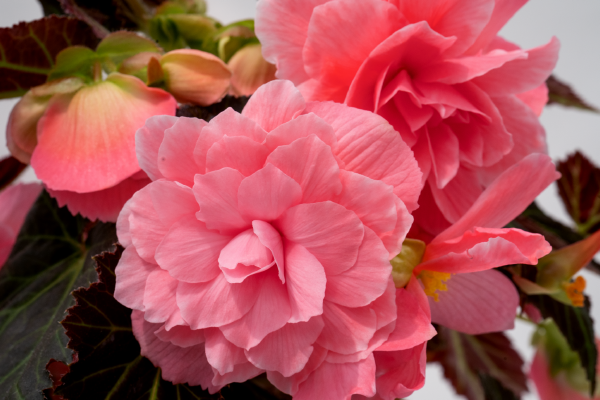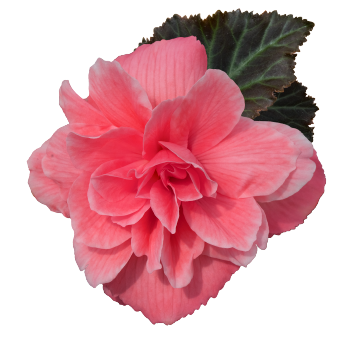

Nonstop Joy® Mocca Rose
Item no.: BT0609PNonstop® Joy — The only Semi-Trailing Tuberous Begonia from Seed
- A multi-purpose begonia suited for premium patio pots and baskets
- Extra large double flowers
- Well-branched plants
- Blooms all summer long
- Easy to produce and easy to ship
Technical Guide: Click here
All information in our technical guide is based on our own trials and would therefore be as guideline only. Detailed cultivation aspects vary depending on climate, location, time of year and environmental conditions. Benary expressly disclaims any responsibility for the content of such data/information and makes no representation or warranty for the cultivation of any products listed. It is recommended that growers conduct a trial of products under their own conditions.
- Crop Time
- Spring: 16 - 18 weeks
- Height ∅
- 9 ″ / 23 cm
- Width ∅
- 9 ″ / 23 cm
- Exposure
- Partial shade - Shade
- Seed Form
- Pelleted Seed
- Best Uses
- Bedding, Hanging basket, Pot Plant
Culture guide
Usage
Pots, Hanging Baskets, Mixed Containers and Landscape
Sowing method
Sow 1-2 seeds or pellets per plug.
Germination
Maintain optimal conditions for seedling development, should begin on the day of sowing until root emergence. Expect root emergence in 7-10 days.
Media
Plug Culture: pH 5.5-5.8; EC 0.5. Begonias are sensitive to high salt levels. Use a well-drained, growing substrate. pH 5.5-5.8; EC 1.25-1.5.
Growing on: Use a well-drained, growing substrate. pH 5.5-5.8; EC 1.0-1.5.
Temperature
Plug Culture: Maintain 22-23°C (72-73°F) until root emergence. Higher temperatures, exceeding 27 °C (80°F) will inhibit germination. Upon radicle emergence, on day 10-14 reduce the temperature to 20-21°C (68-70°F) until cotyledon expansion. On day 21 the temperature can be reduced further to 20°C (68°F). For irrigation use warm water (above 18°C/ 64 °F) only. Maintain the ideal temperature to achieve the shortest crop time on days 28-42 keeping the temperature 20-21°C (68-70°F). A slightly lower temperature of 19-20°C (66-68°F) will reduce stretch in the seedlings. Tuberous begonias are very responsive to DIF where a 1-2 °C (34-26°F) DIF will also keep plants compact. Once roots have reached the bottom of the tray, (after day 42), the temperature can be lowered to 18-19°C (64-66°F).
Growing on: After transplanting maintain 18-20°C (64-68°F) nights for the first 14 days or until the roots reach the bottom of the container. Thereafter temperatures may be lowered to 16-18°C ( 60-64°F). An ADT (average daily temperature of 19°C (66°F) will give the fastest finished crop. Temperatures below 14°C (57°F) will result in tuber formation and delay the crop. A DIF of 1-2°C (34-36°F) will result in a more compact crop requiring little to no growth regulators.
Fertilization
Begin fertilizing early once germination is complete, approximately day 14 lower rates of feeding at 50 ppm 2-3 times per week will help to size up the seedlings. Under higher light conditions use a 20-10-20 fertilizer and under lower light a 17-5-17. Once seedlings are established the 17-5-17 fertilizer works well. Include a micro nutrient package to give adequate supply of minor elements. Alternate between a calciumbased fertilizer (14-4-14 or 15-5-15) and an ammonium-based fertilizer (17-5-17) at 50- 100 ppm nitrogen every 2-3 waterings. Fertilizer applications can be gradually increased in the later stages of bulking where a constant feed at 100 ppm is used. Under high light and long days an ammonium-based fertilizer 20-10-20 at 50-100 ppm can also be used.
Growing on: Alternate between calcium-based fertilizer 14-4-14 and an ammonium fertilizer 17-5-17 at 100-150 ppm. Keep the media EC at 1.5. Application of potassium nitrate can help to keep the plants more compact. Under higher light and warmer temperatures a fertilizer with additional ammonium can be used. Tall, stretched plants with few flowers indicate too much ammonium. Stunted, chlorotic plants with marginal leaf burn indicate a lack of calcium and magnesium. Under high light and extended day length an ammonium-based feed (20-10-20) at 100-150 ppm nitrogen can also be used.
Tip
Nonstop Joy® has excellent branching and continuous flowering all season long. Will actually finish 5-7 days earlier than the other Nonstop® series.
Stage I Starts with the radicle breaking through the testa. The roots are touching the medium. Ends with fully developed cotyledons.
Stage II Starts from fully developed cotyledons. Ends with the fully developed true leaf or true leaf pair.
Stage III Starts from the fully developed true leaf or true leaf pair and ends with 80% of the young plants being marketable.
Stage IV All young plants are ready for sale and in the process of being hardened off. This stage lasts about 7 days.
The cultural recommendations are based on results from trials conducted under Central European conditions. Different conditions in other parts of the world may lead to deviations in results achieved.






